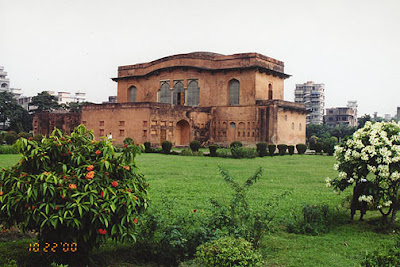
Lalbagh Fort, an incomplete Mughal palace fortress in Dhaka stood on the banks of the river Buriganga in the southwestern part of the old city. The river has now moved further south and flows at Quite a distance from the fort. D’Oily’s painting (1809-1 I) shows that more than half of this east-west oblong fortress touched the water of the river on its southern and southwestern sides. The construction of the fort was commenced in 1678 AD by Prince Muhammad Azam during his I 5 month long vice-royalty of Bengal.
For a long time the fort was considered to be a combination of three buildings (the mosque, the tomb of Bibi Pari and the Diwan-i-Aam), two gateways and a portion of the partly damaged fortification wall. In the present fort area of 7.2 hectares, excavations have revealed the remains of structures. Of the three surviving gateways, the southern one is the most imposing. Seen from the front it is a three-storied structure with a fronton, bordered with slender minarets. From inside it gives the impression of a two-storied structure.
A water channel with fountains at regular intervals connects the three buildings from east to west and two similar channels run from south to north. The building in the middle, the tomb of Bibi Pari, is the most impressive of the surviving buildings of the fort. Eight rooms surround a central square room, containing the mortal remains of Bibi Pari, which is covered by a false dome. Octagonal in shape, and wrapped by brass plate. The entire inner wall of the central room was covered with white marble. While the four side central rooms had stone skirting up to a height of one meter. The wall in the four corner rooms was skirted with beautiful glazed floral tiles. The tiles have recently, been restored; two of the original tiles have been retained. The southeastern corner room contains a small grave, popularly known to be of Shamsad Begum, possibly a relative of Bibi Pari. The Lalbagh Fort Mosque is a three-domed mosque with a water tank




No comments:
Post a Comment